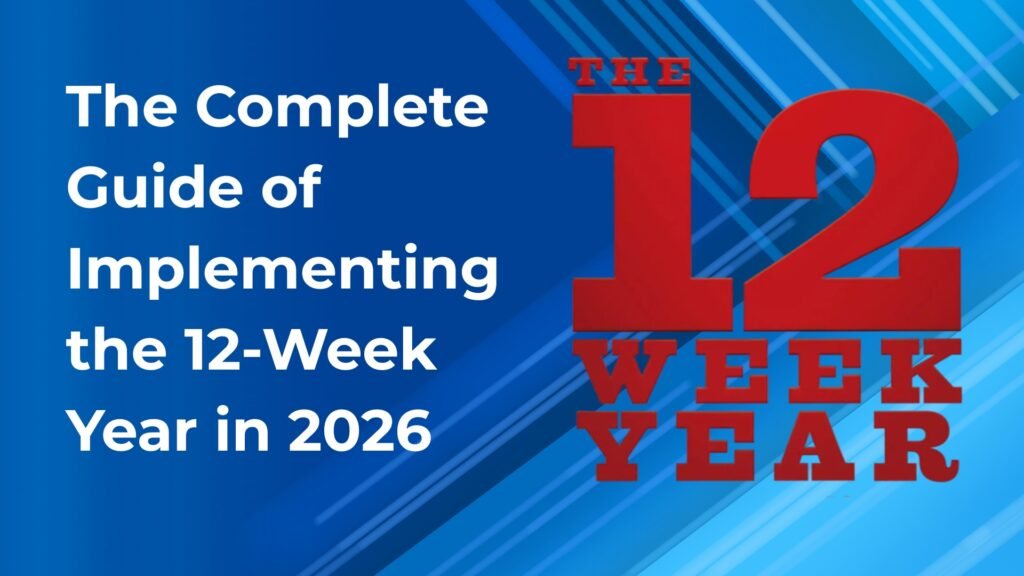
Nov. 9th, 2025


This guide helps you apply the 12-Week Year framework step by step — turning strategy into action and goals into measurable results.
Written by Dan Mintz, a leading productivity strategist, expert in the 12 week year, and the founder of the 12-Week Breakthrough Program. Wharton MBA, MIT Data Scientist, 3x Entrepreneur.
Worked with dozens of people to transform their lives in 12 weeks.
If you’ve ever started a new year full of ambition only to see your motivation fade by March, you’re not alone. Traditional annual planning creates a false sense of time abundance—twelve months feels comfortable, but comfort kills urgency.
The 12-Week Year flips that model completely. It condenses your execution window into focused, high-intensity 12-week cycles—giving you four “years” of achievement inside a single calendar year.
This complete 2025 implementation guide walks you step-by-step through applying the 12-Week Year so you can achieve in three months what most people need twelve for. Whether you’re a professional, entrepreneur, or student, this system helps you translate goals into measurable action through clarity, accountability, and rhythm.
The 12-Week Year is built on one radical idea: shorten the horizon, sharpen the focus.
Instead of chasing vague annual resolutions, you’ll define one to three SMART goals—Specific, Measurable, Achievable, Relevant, Time-bound—per 12-week cycle. Research by Locke & Latham shows that specific and challenging goals consistently drive higher performance than “do your best” intentions.
Twelve weeks is long enough to make meaningful progress, yet short enough to sustain intensity. You gain the psychological benefits of urgency without the burnout of perpetual sprinting.
Each cycle becomes a complete performance loop: plan → execute → measure → review → reset. That cycle itself becomes the engine of continuous growth.
Behind the mechanics lies a deeper motivational design.
According to Deci & Ryan’s Self-Determination Theory, lasting motivation arises when three psychological needs are met: autonomy, competence, and relatedness.
The 12-Week Year satisfies these by giving you:
Autonomy: you control the plan and your schedule.
Competence: clear scorecards show progress weekly.
Relatedness: accountability partners or peer groups keep you connected.
This combination transforms willpower into intrinsic drive—the kind that lasts.
Limit goals per cycle. Too many objectives dilute effort. Use the OKR mindset: Objectives (the “what”) and Key Results (the measurable “how”).
Example:
Objective: Increase client acquisition rate.
Key Results: Publish 12 LinkedIn articles, hold 4 webinars, reach 15 new qualified leads per week.
Translate goals into weekly lead actions. The 4 Disciplines of Execution (4DX) call these lead measures—the controllable behaviors that predict results.
Strive for at least 85% task completion weekly. This target—borrowed from performance research and the EOS (Entrepreneurial Operating System) by Wickman—balances ambition and realism.
Use a simple visual scoreboard or spreadsheet. Color-code completion rates to make progress visible. Visibility drives accountability.
End every week with a quick review:
What did I complete?
What stalled and why?
What’s my single highest-impact action next week?
This rhythm keeps execution agile, preventing drift and overwhelm.
Gerber’s E-Myth Revisited teaches that great systems outperform great intentions. Pair up with an accountability partner or join a weekly review group. Public commitment boosts follow-through dramatically.
After each 12-week sprint, dedicate a 13th Week to reflection and recovery:
Assess your scorecard.
Celebrate wins.
Identify process gaps.
Rebuild your next 12-week plan.
Borrow a page from The Lean Startup methodology: treat each cycle as an experiment. Measure outcomes, test assumptions, and “pivot or persevere” based on feedback.
The 12-Week Year isn’t just about short-term productivity—it connects daily action to long-term meaning. Start with a three-year vision: what kind of person or professional do you want to become?
Then cascade that vision down into 12-week outcomes. This alignment ensures your actions serve both short-term performance and long-term identity.
Use the EOS V/TO (Vision/Traction Organizer) concept to clarify:
Core Vision: where you’re headed.
Traction Plan: how you’ll get there.
This bridge between inspiration and structure keeps execution emotionally charged yet strategically grounded.
Setting too many goals → diffusion of focus.
Skipping weekly reviews → loss of accountability.
Treating tasks as goals → focus on outcomes, not busywork.
Neglecting reflection → repeated mistakes each cycle.
Working in isolation → progress collapses without feedback loops.
Remember: consistency beats intensity. The 12-Week Year is a system of rhythm, not

| Week | Focus | Key Activities |
|---|---|---|
| 1–2 | Vision & Goal Setup | Define SMART goals, build plan, create scorecard |
| 3–5 | Execution Ramp-Up | Implement weekly actions, hold accountability check-ins |
| 6–9 | Deep Execution | Track progress, refine lead measures |
| 10–11 | Optimization | Fix process gaps, double down on high-ROI actions |
| 12 | Review & Celebrate | Evaluate performance, log lessons learned |
| 13 | Reset | Plan the next cycle |
It integrates principles validated across multiple performance systems:
Goal Setting Theory → clear, measurable, challenging goals enhance motivation.
Self-Determination Theory → autonomy + competence + relatedness fuel intrinsic drive.
4DX & Traction Models → lead measures, scoreboards, and accountability cycles ensure execution.
Lean Startup Feedback Loop → measure, learn, adjust rapidly.
This synergy explains why teams using 12-week cycles often report 30–40% higher goal-completion rates and sharper focus across projects.
The 12-Week Year is more than a planning tactic—it’s an operating system for focused living.
By compressing time, defining SMART goals, and building weekly accountability, you’ll cultivate clarity, discipline, and measurable momentum.
Stay committed to the process, not perfection. Every 12-week cycle becomes another strategic iteration in your personal and professional growth.
Whether you’re pursuing fitness, scaling a business, or writing a book, this framework converts ambition into consistent achievement—one focused quarter at a time.
Make 2025 the year you finally stop planning endlessly—and start executing relentlessly.
1. What makes the 12-Week Year different from OKRs or EOS?
OKRs emphasize alignment and transparency across teams, while EOS focuses on business-level traction. The 12-Week Year provides the personal execution rhythm that makes both systems actually work day-to-day.
2. How do I stay accountable if I work alone?
Use public accountability: post your scorecard weekly, join an online mastermind, or record short progress logs. Externalizing progress creates commitment pressure.
3. Can I use the system for personal goals like health or learning?
Absolutely. Many apply it to fitness, writing, or habit-building—any goal that benefits from structure and short-term focus.
4. How much time should weekly planning take?
About 30–45 minutes. The goal is clarity, not complexity. One page per week is enough.
5. What if I miss a week or fall behind?
Don’t restart—recalibrate. Identify the lead measures you neglected, revise the plan, and continue. Momentum matters more than perfection.
6. Are there tools that simplify 12-Week Year tracking?
You can use Excel, Notion, TickTick, or specialized planners. The best tool is the one you’ll actually update weekly.

Dan Mintz is the creator of the 12 Week Breakthrough Program. He advised dozens of individuals on how to achieve their most ambitious goals and reach their full potential.
Dan can be reached at:
dan.mintz@12week-breakthrough.com
About Dan Mintz
Additional Links:
Join the Program
Our Blog Page
Amazing Productivity Blogger
Social Links:
LinkedIn
X / Twitter
Instagram